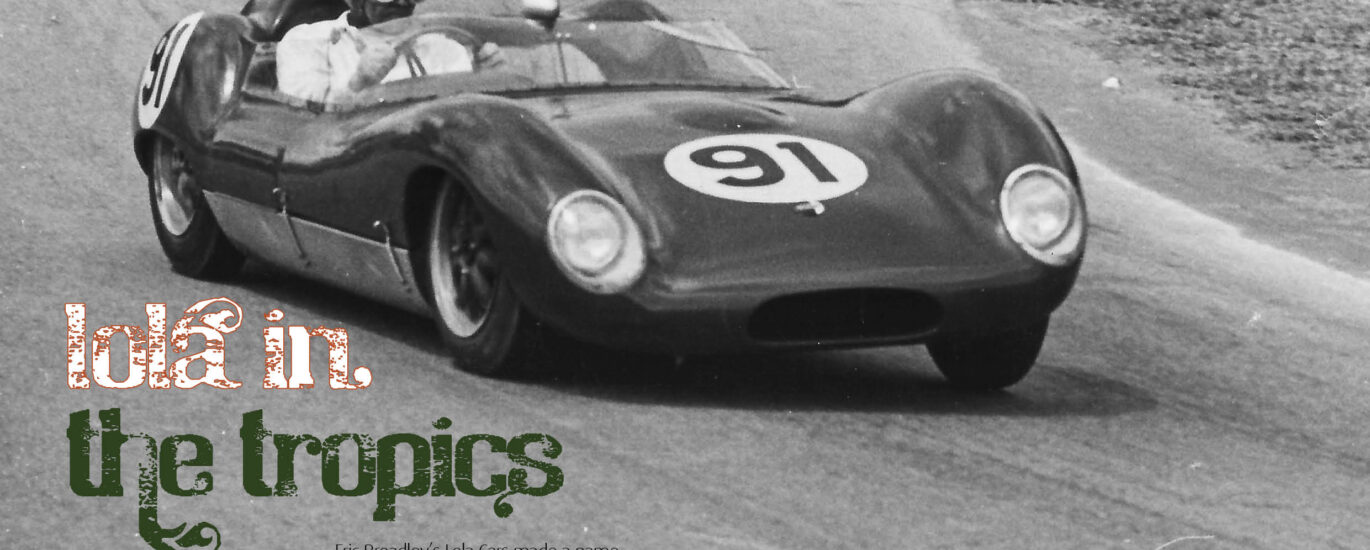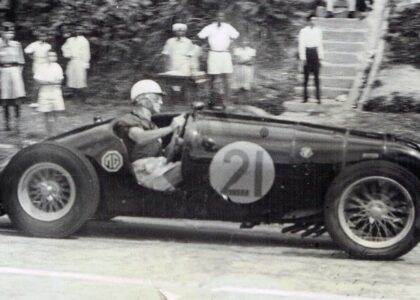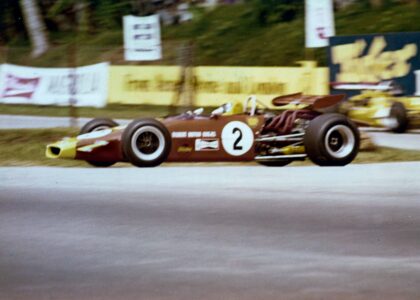By Eli Solomon
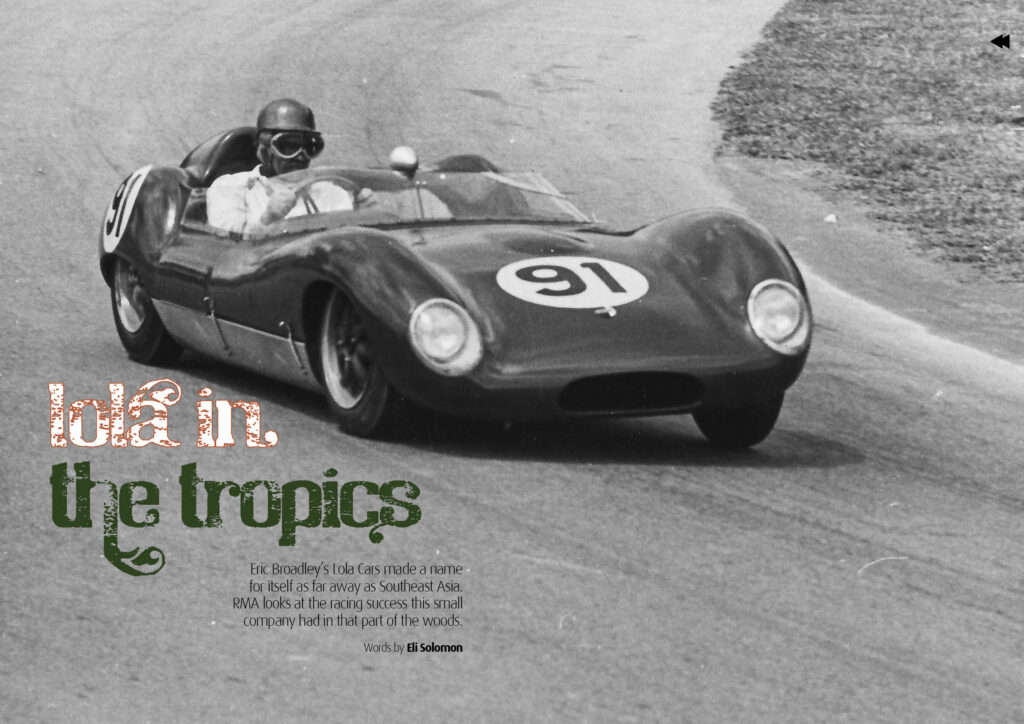
British sports car companies of the 1950s and 1960s often had some bizarre names. Lotus Cars was perhaps the most famous. But there was also Buckler, Chevron, Daren, Diva, Elva and Lola. With a name like Lotus you could always come up with a good story. Elva, we know, is French for ‘She Goes’.
But what of Lola? A play on Lotus-Last perhaps? Or was it taken from the song, “Whatever Lola Wants, Lola Gets,” from the 1955 musical play Damn Yankees? There is something of the red-haired seductive temptress in the Lola name.
There were two key ingredients that made it possible for the likes of Cooper, Kieft and Lotus to develop low cost racing cars in the 1950s. One was the burgeoning motoring club scene; the other was the ready availability of engines from Ford. Everybody wanted to emulate or improve on Colin Chapman’s Lotus in the 1950s, and Eric Broadley was no different.
The British car scene of the 1950s was made up of quick thinking and industrious men, most from the aviation sector, men who were prepared to try out new ideas and push the envelope of development well beyond what their predecessors had accomplished.
FAR EAST LOLAS
Out in the content consumer Far Eastern market, a trickle of such “kit” cars made their way over for the various sprints, hill climbs and circuit races. While Lotus already had a popular presence with its Seven, Eleven, 15 and 17 prior to the 1960s, the first Lola, a Mk1 Climax FWE, only arrived in Singapore in 1961.
Towards the end of the 1970s, only the open wheeler Lola T460 could be seen in action in Far East motor racing, with marques such as Chevron, March and Ralt dominating the sport.
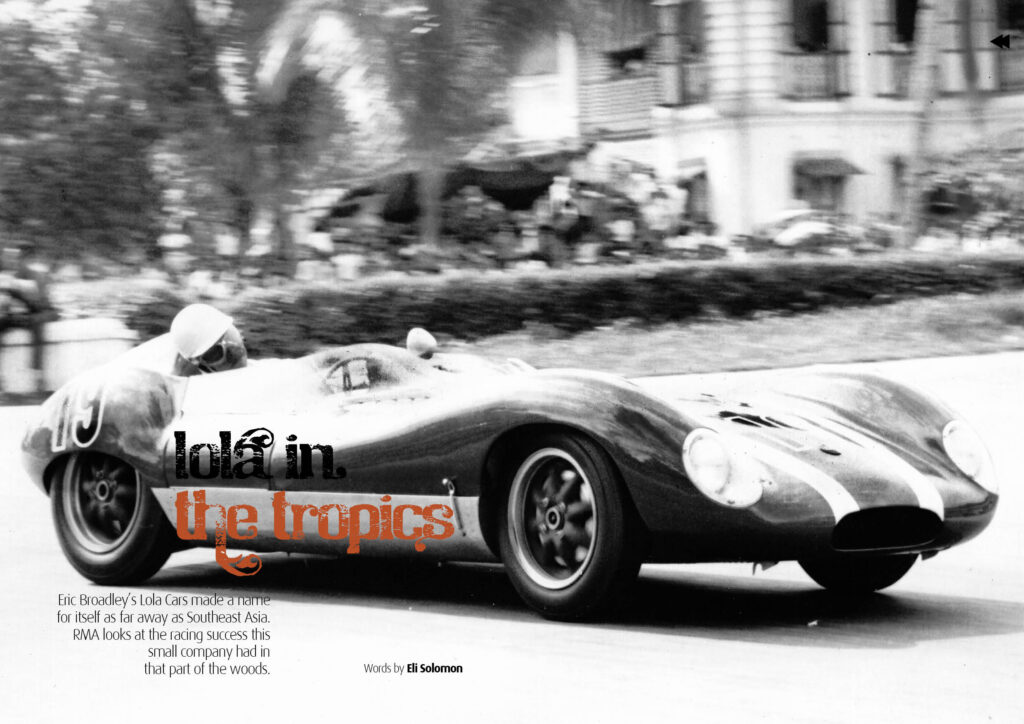
Victory straight out of the box – this Lola Mk1 FWE Climax at the 1961 Johore Grand Prix. See JOHORE GRAND PRIX – Part 2: 1960-1963
WINNING LOLA
To win a Grand Prix requires the best possible machine money can buy, as well as the best support, tyres, strategy, and a sprinkling of good fortune. Chan Lye Choon, Singapore’s top racer of the late 1950s and early 1960s, knew that his pair of working Coopers with their JAP motorcycle engines may have been the most potent in a straight line sprint, but they were totally hopeless over a 60-lap Grand Prix.
Chan, owner of automobile importer Eastern Auto, was well aware of what the Lotus Eleven Le Mans Climax, the clubman sports car of choice in the late 1950s, was capable of, having seen Tony Huggett and Peter Heath in action in Singapore. Chan would also have read about a new outfit set up by Eric Broadley at Bromley in Kent called Lola Cars. He needed something good to beat the Lotus, perhaps even something with a similarly powered racing engine, fettled for the tropics of course.
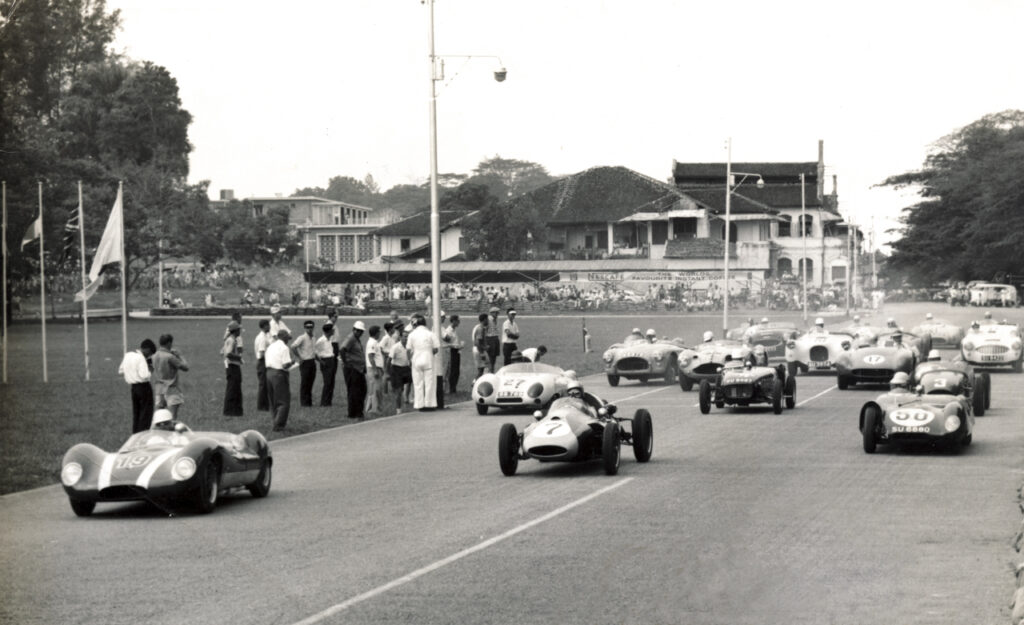
Chan Lye Choon’s $17,000 green with white striped Lola Mk1 FWE Climax streaks off at the start of the 1961 Johore Grand Prix Grid ahead of Peter Cowling’s T51 Cooper Climax (#7). Chan brushed off several wheel-to-wheel battles with Cowling as well as Peter Brown in a Lotus 17 before emerging winner in the 70-lap race. Story of the Johore Grand Prix in JOHORE GRAND PRIX – Part 2: 1960-1963
The Lola Mk1 Climax had all the right ingredients for the task at hand. It had the requisite low weight, independent suspension and reliability. Chan immediately ordered one with the larger 1,216cc FWE Coventry Climax single cam engine paying S$17,000 (just over £2,000) complete with transmission. The Lola would officially debut at the 24-25 June 1961 Johore Grand Prix.
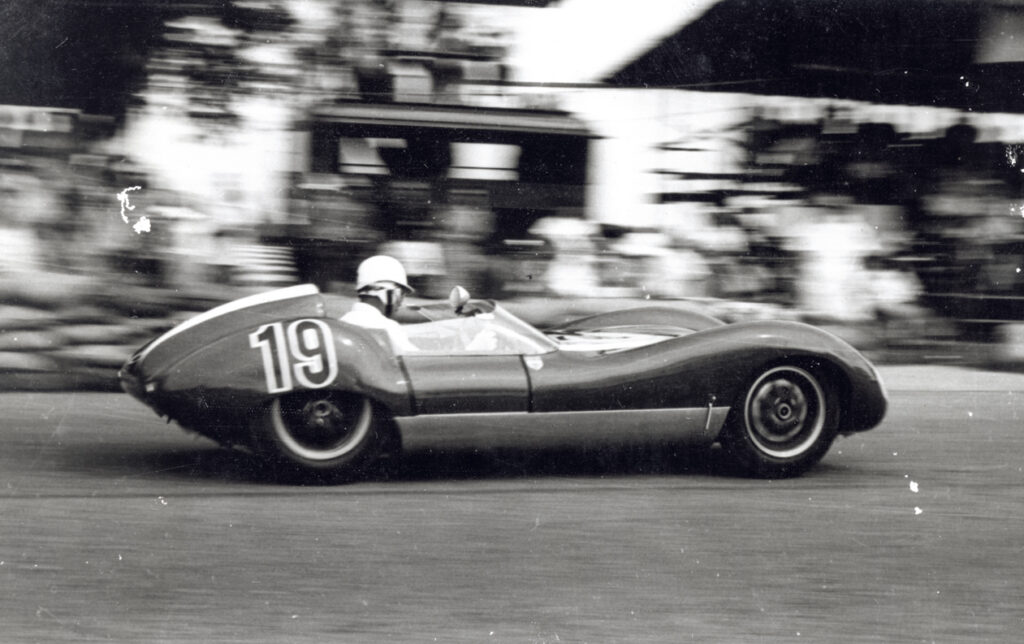
The inaugural race of the Lola Mk1 FWE Climax – victory at the 1961 Johore Grand Prix for Chan Lye Choon.
The 1961 Johore Grand Prix was a 70-lap affair run to Formula Libre rules that featured everything ranging from a bored-out Austin Mini, a single-seater 1.5-litre Cooper Climax FPF T51 Formula 2 car [see COOPERHOLIC COUP], a Cooper Jaguar [see JUNGLE WARRIOR] putting out a reputed 228bhp, an Aston Martin DB3S [see FOR THE PRICE OF A HOUSE], a couple of Lotus Eleven Climaxes, a Lotus 17 Climax, and a Ferrari Monza [see JUST THE RIGHT AMOUNT OF TORQUE]. For the history of the Johore Grand Prix (1960-1963) see JOHORE GRAND PRIX – Part 2: 1960-1963
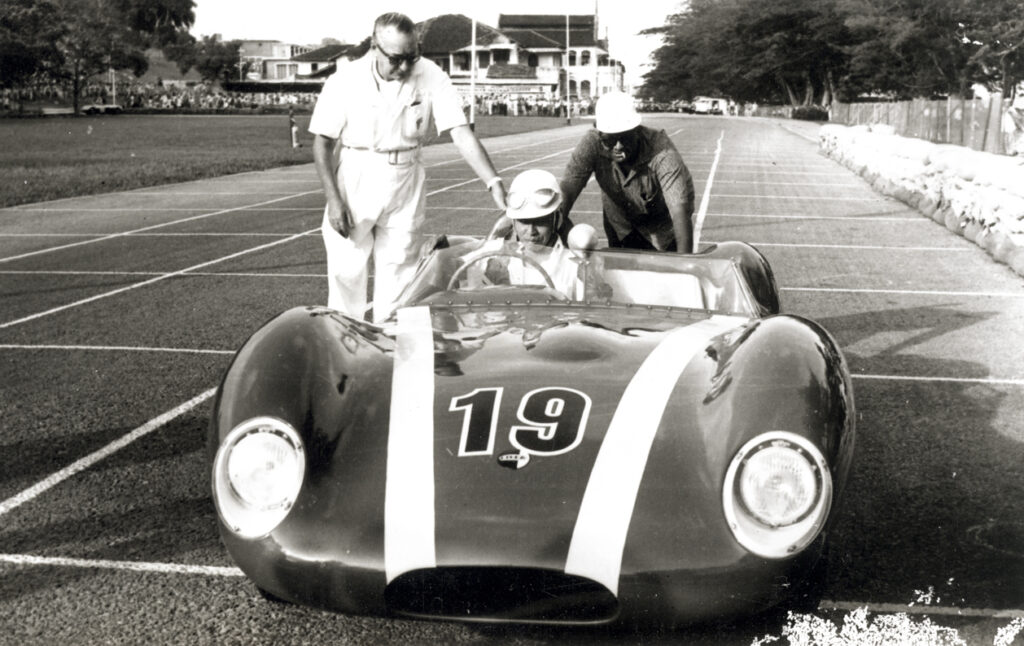
Singapore Motor Club president Freddy Pope alongside the victorious Chan Lye Choon after the 1961 Johore Grand Prix.
Chan’s Lola dominated from the onset and won. Peter Cowling may have set a new lap record in the fragile T51 Cooper F2, but the single-seater crashed into the sandbags early on. The Lola had won straight out of the box and Chan bagged his third circuit win after Changi in 1957 [see LANDING AT CHANGI IN 1957] and Macau in 1958. The Mk1 Lola effectively replaced his Aston Martin DB3S and he resumed his winning ways at the Gap Hill Climb on 22 October 1961 with a class record.
At the 1961 Macau Grand Prix on 19 November the car sat on pole, alongside Alistair Stewart in a Lotus 18 and Bill Baxter in a Jaguar E-Type. The Lola DNF-ed. The Lola was replaced by a Lotus 20B for the 1962 season and was occasionally lent to Chan’s friend Jimmy Milne[end_note] James Alexander Milne, or Jimmy Milne to his friends, was born in Penang in 1910 to Capt. James Adam Milne (of Dysart, Fife, Scotland) and Lilian Grace Holmberg. Jimmy’s racing interests date back to the late 1920s at the Singapore Volunteer Corps/Straits Settlements Volunteer Force Gap Hill Climb. He continued to play an active part in Malayan/Singapore motor sports, racing in the 1940 Johore War Effort Grand Prix [see GENESIS & THE WINDS OF WAR]. Milne worked for Universal Cars and then in the Singapore civil service, leaving to rejoin Universal Cars. In 1960 he became the first Malayan-born manager of the company. In March 1962 Jimmy and his family moved to Shanklin in the Isle of Wright, ending what the local media called “the long and colourful career of one of Malaya’s most popular motor-racing personalities.” Things didn’t go according to plan and finding a job in the UK was difficult. Jimmy returned to Singapore in March 1963 to join George Lee Motors as its Assistant General Manager. One of his roles was helping in the preparation and entry of the recently announced race-tuned Ford Cortinas in local racing events. That year he raced in the Grand Prix in Singapore. He returned to the UK later in the year. Milne passed away 19 February 1998 at the age of 87. [/efn_note] (who raced it at the 1963 Singapore Grand Prix). That wasn’t the end of Chan’s association with the little Lola. It won the Under 1,300cc Sports & GT Cars support race at the November 1963 Diplomatic Enclave races1 in Kuala Lumpur.
The Mk1 went to a number of hands following the sale of the car by Chan before Ken Evans got his hands on the car in the early 1970s and raced the car in a support race of the 1972 Singapore Grand Prix. The car later found its way to Australia where it was restored and continues to be raced.
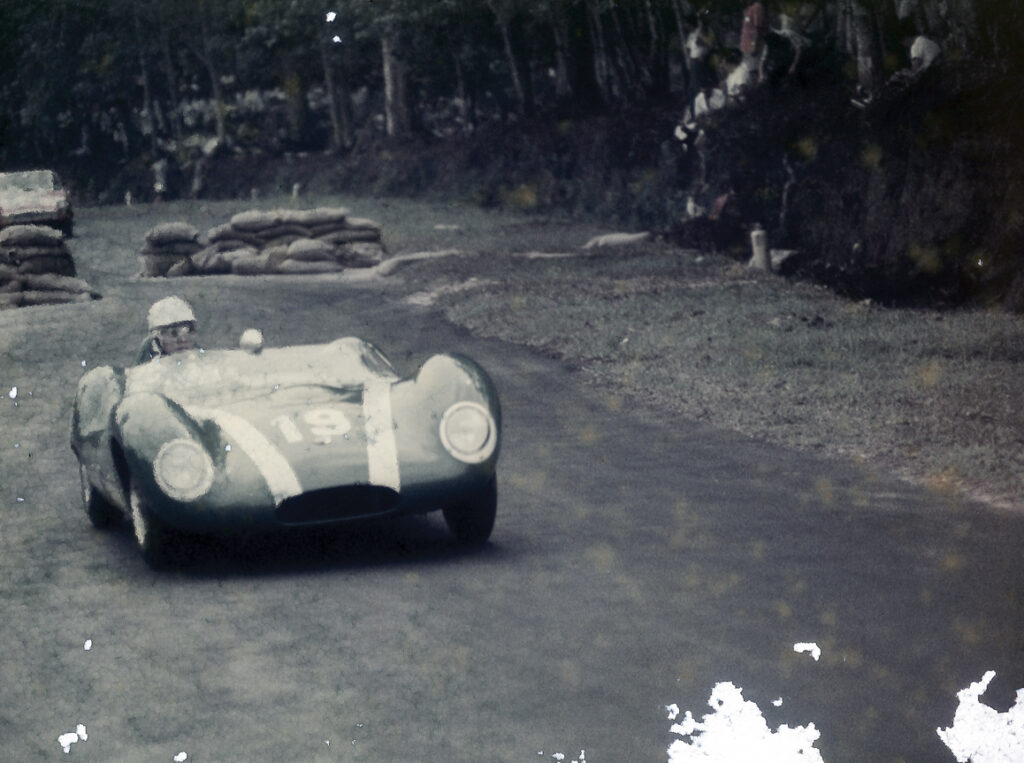
A Lola Mk1 FWE Climax arrived at the scene in 1961, specifically imported by Eastern Auto’s Chan Lye Choon to race in Johore and Singapore. Chan’s hopes of a double were dashed in Singapore before half distance when the fan belt burst. The Lola would still emerge as the fastest car on the track that day setting fastest lap at 2:47 sec. on lap 14. The Lola also had special long-range tanks for the 60 lap Grand Prix.
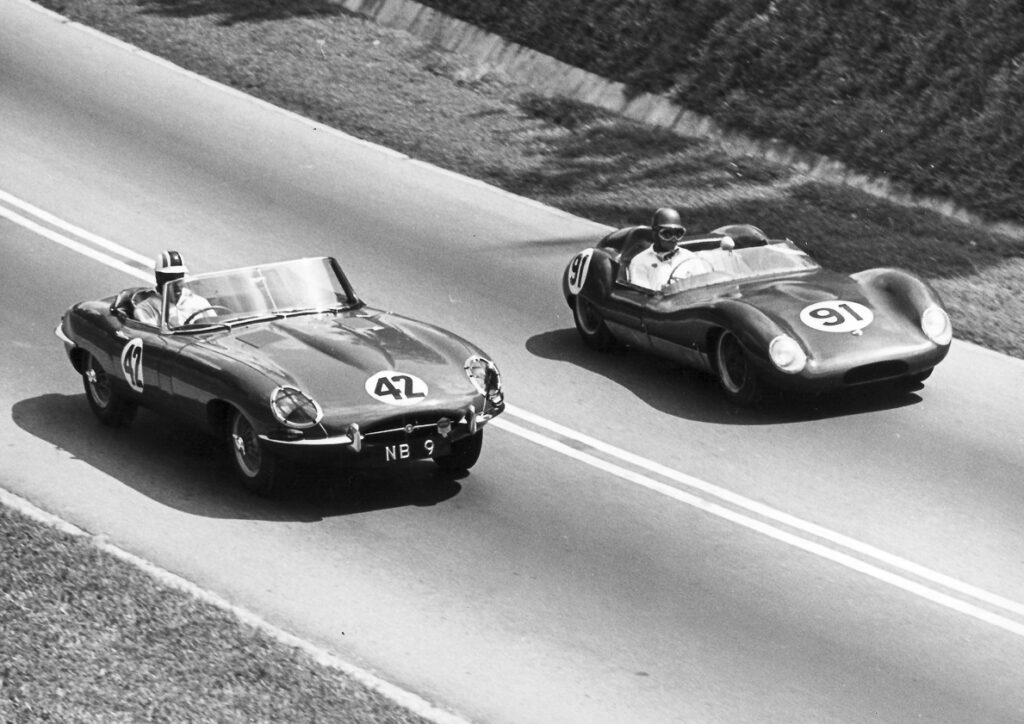
Jimmy Milne spent part of 1963 back in Singapore working for George Lee Motors. He raced Chan Lye Choon’s Lola Mk1 at the 1963 Grand Prix. The Jaguar alongside is the Leonard Eric Jansz2 car that finished second in the 1962 Grand Prix in Singapore.
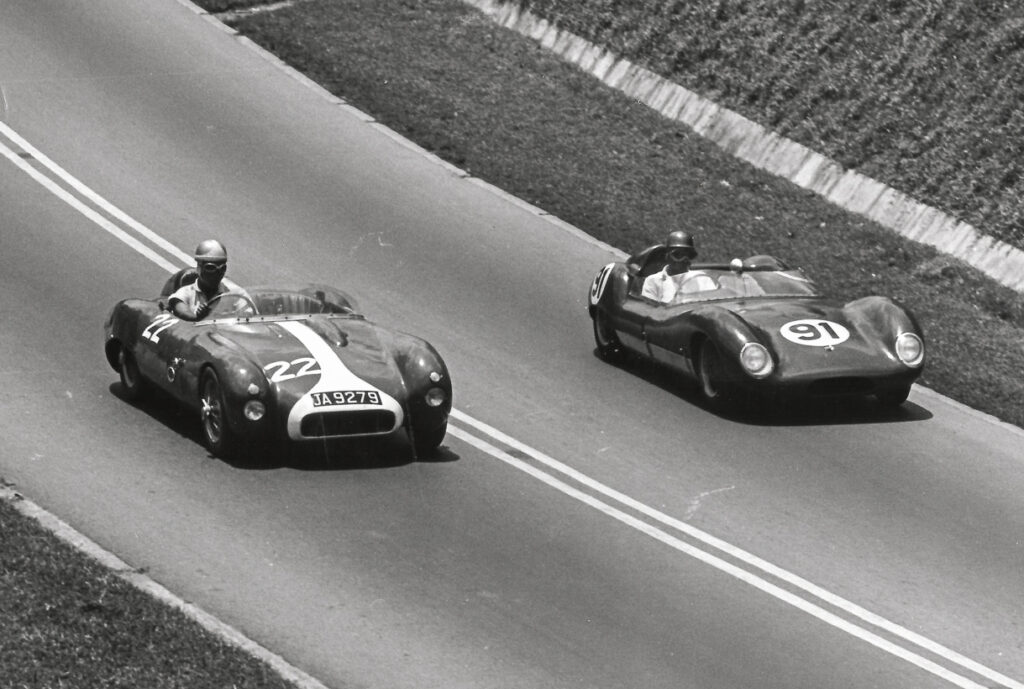
Jimmy Milne and the Chan Lola Mk1 alongside what was listed as the Nothing Special (probably the BB Special – see BAMBOO & BUCKLER) during the 1963 Grand Prix in Singapore.
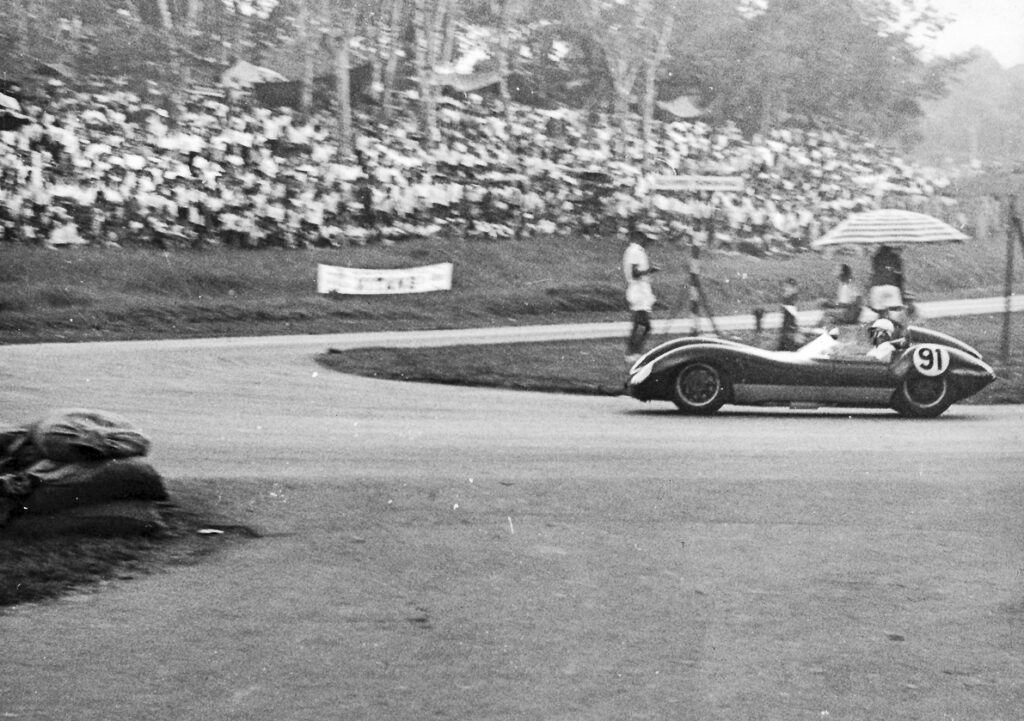
Jimmy Milne rounding Sembawang Circuit in the Lola during the 1963 Grand Prix in Singapore.
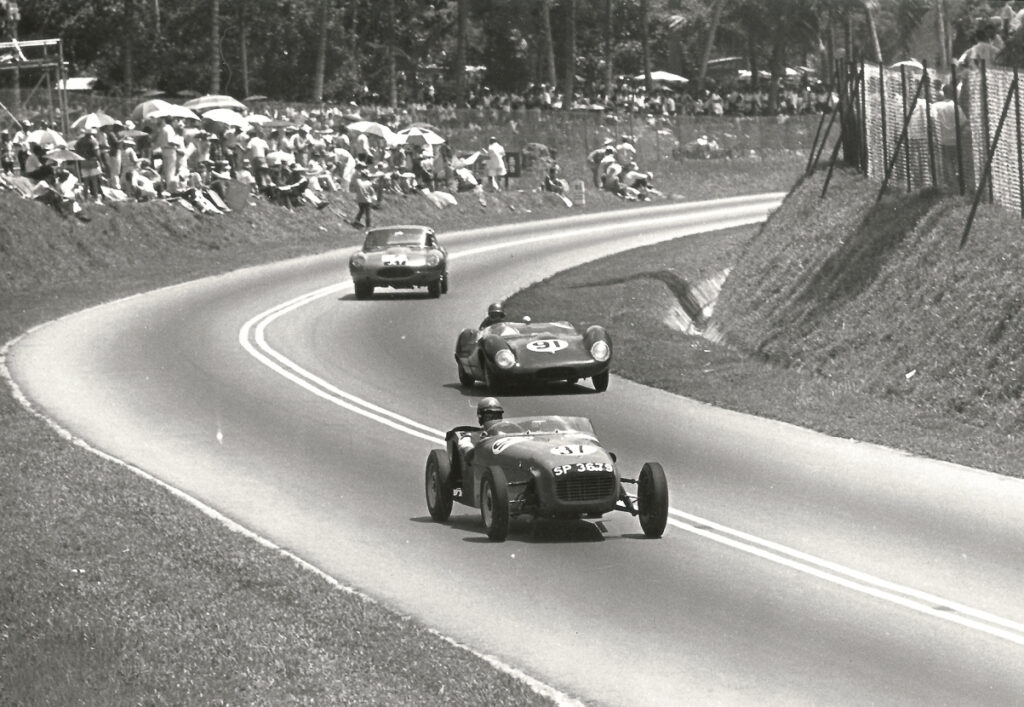
Out of Range Hairpin and onto Thomson Mile during the 1963 Grand Prix in Singapore. The #91 Lola about to pass the Peter Leonard’s very quick stripped-out road registered Lotus Super Seven.
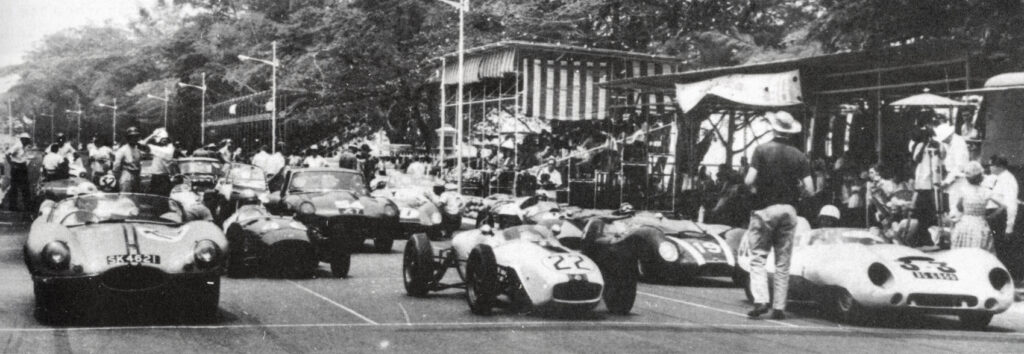
A second row start for Chan Lye Choon (#19 Lola Mk1 Climax) in the 1963 Johore Grand Prix, a race he DNF. At the sharp end are L to R: Yong Nam Kee (Jaguar D-Type); John Kirk – making his debut in Malaysia (Lotus 18); and Saw Kim Thiat (Lotus 15). See JOHORE GRAND PRIX – Part 2: 1960-1963
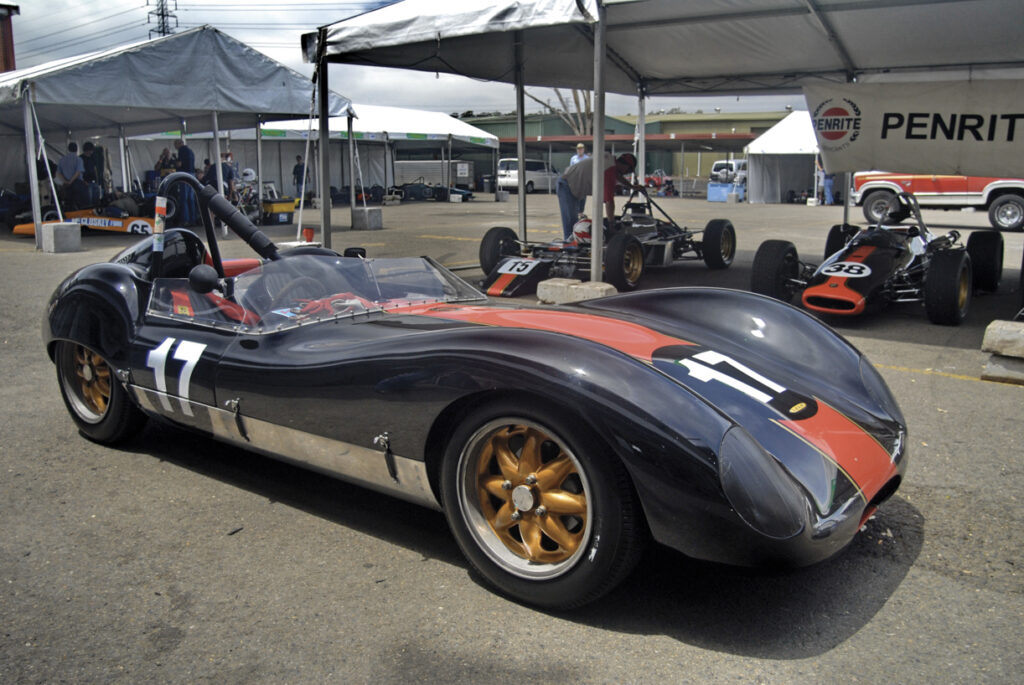
The ex-Chan Lola Mk1 Climax at Eastern Creek for the first Tasman Revival weekend in November 2006. The Brabham in the Penrite tent is the ex-Jan Bussell car that won the 1968 Macau Grand Prix.
MORE LOLAS
This, incidentally, was not the only Mk1 Lola to race in the region. Lord Angus Clydesdale, a reconnaissance pilot for the British Forces in Singapore, had a similar model but few knew what it was after it took a beating at during practice before the 1963 Grand Prix in Singapore. The RAF crew attending to it promptly went to work and created another ‘Special’, ready for the 1963 Johore Grand Prix, where the car finished second.
The Lola repeated that feat in the TAR races at Kuala Lumpur’s Diplomatic Enclave on 16-17 November 1963, finished second to Public Works Department engineer John Wright in a Jaguar E-Type Coupe. Previous year’s winner Chan Lye Choon (in his Lotus 20B), who trailed Wright for most of the race, dropped back to finish fourth in his Lola Mk1 Climax when the weather turned foul.
Earlier in October 1963, the Lola RAF Special was offered for sale in the Forces Driving Club Gazette, complete with 1,097cc Climax motor for SG$7,000.
In 1964, Gordon Haddock was entered to run the Clydesdale Lola Special in the Singapore Grand Prix while Clydesdale would run his 1,499cc Gemini Mk3. Clydesdale destroyed the Lola’s axle during the Sports & GT race. In any case the 1964 Grand Prix was red flagged due to calamitous weather.
The last occasion the car was seen in action in Asia was at the 11-12 April 1965 Grand Prix in Singapore.
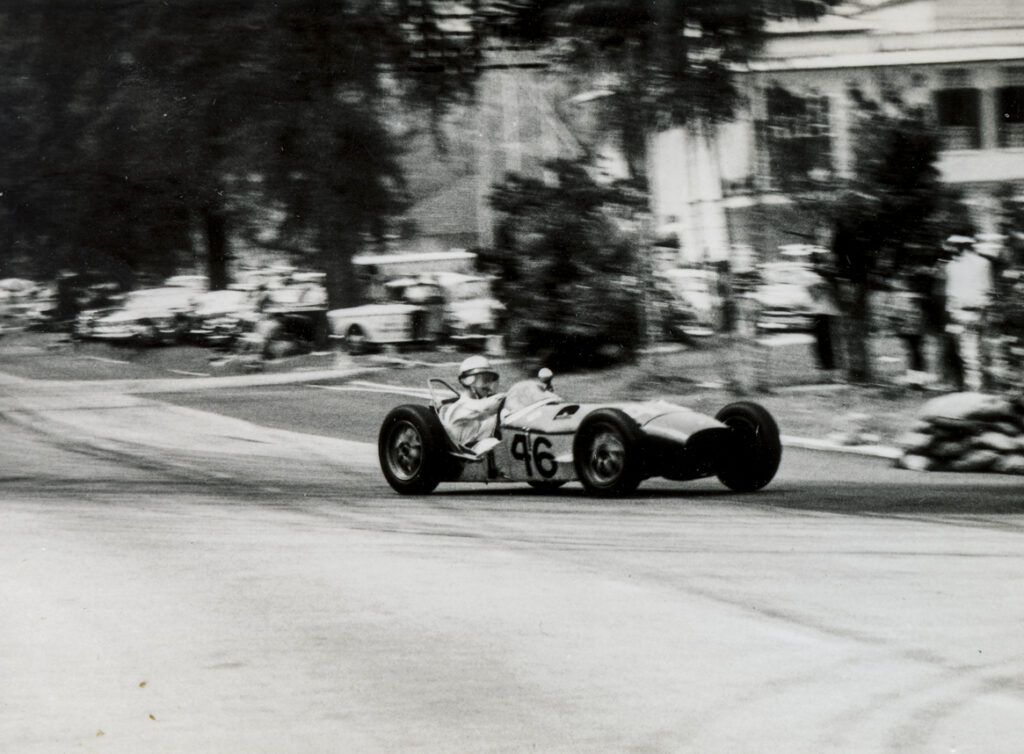
The rebuilt Lola Mk1 RAF Special finished second in the 1963 Johore Grand Prix.
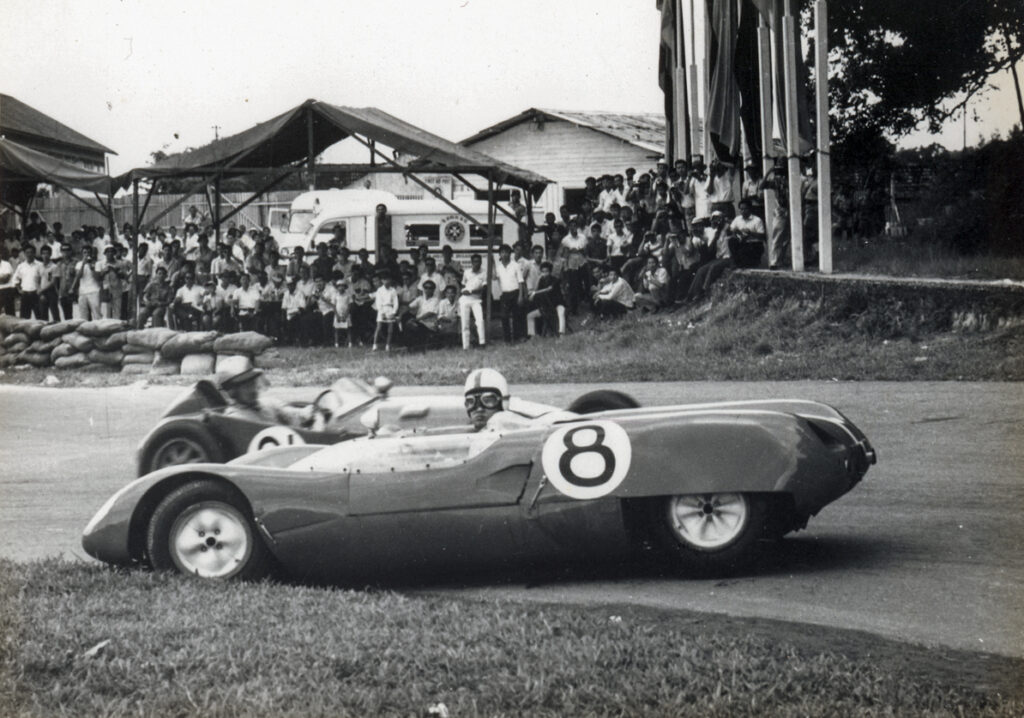
Lotus versus Lola in Singapore in 1965. Angus Clydesdale adroitly avoids Lee Han Seng’s spinning Lotus 23B [see CASE BOOK OF 23S] at the entry into The Snakes.
GOODWIN’S LOLA
Dr Tony Goodwin’s imported Lola Mk2 first participated in Malaysia at the Tengku Abdul Rahman Petaling Jaya street races 5-6 July 1964. The front engine car had a BMC Morris Minor 998cc motor and was used by Goodwin at the Forces Driving Club and Singapore Motor Club Sprints. At the end of the year, Goodwin had the orange car flown to Macau for the Grand Prix3. A 1,650cc Ford Cortina GT engine soon replaced the Morris Minor motor and Major John Harwood had an adapter plate made for the “unsuspecting” Austin A30 gearbox.
Back in Singapore, he impressed with a third place finish in the 1965 Grand Prix in Singapore on 12 April. Jan Bussell raced it at the TAR street races 3-4 July 1965, then at the Singapore Grand Prix in April 19664. Bussell continued to race the car before offering it for sale in August 1967 – complete with trailer, 1500cc Ford motor, Cosworth head and cam, Weber carbs and a close ratio transmission. Bussell appears to have retained the car until July 1974 when it was advertised once again by his Torque Shop – asking price RM$750! 5 Interestingly, the chassis number on the car was SAG 4 – which the fourth car S. Anthony Goodwin owned!
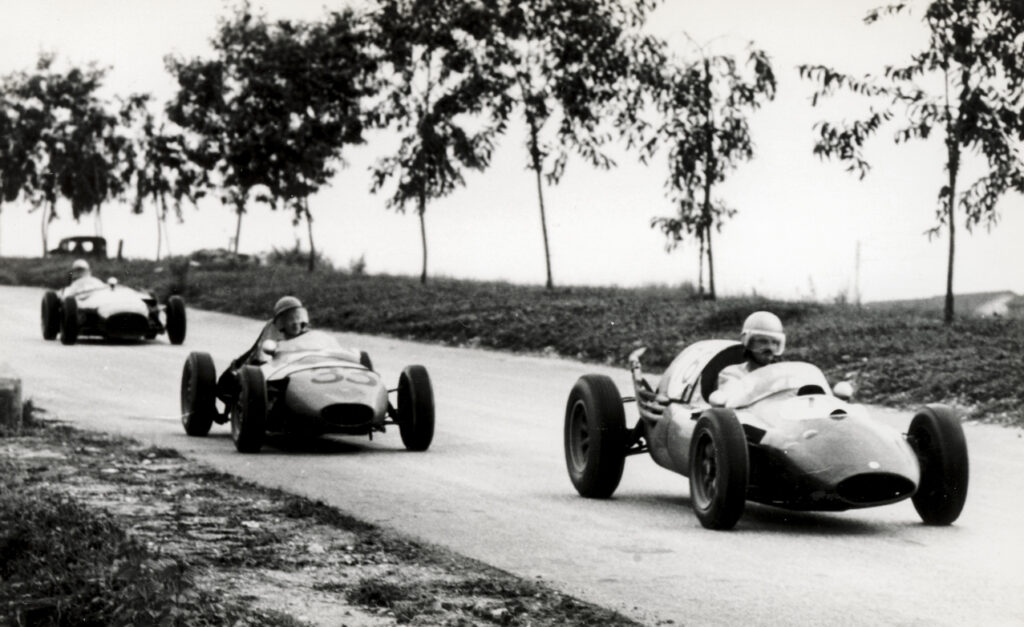
Dr Tony Goodwin’s new import to Malaya was the #33 Lola Mk2 998cc BMC at the Tengku Abdul Rahman Petaling Jaya street races 5-6 July 1964. The Lola trails Colonel Mike Hunt’s T51 Cooper Climax [see COOPERHOLIC COUP].
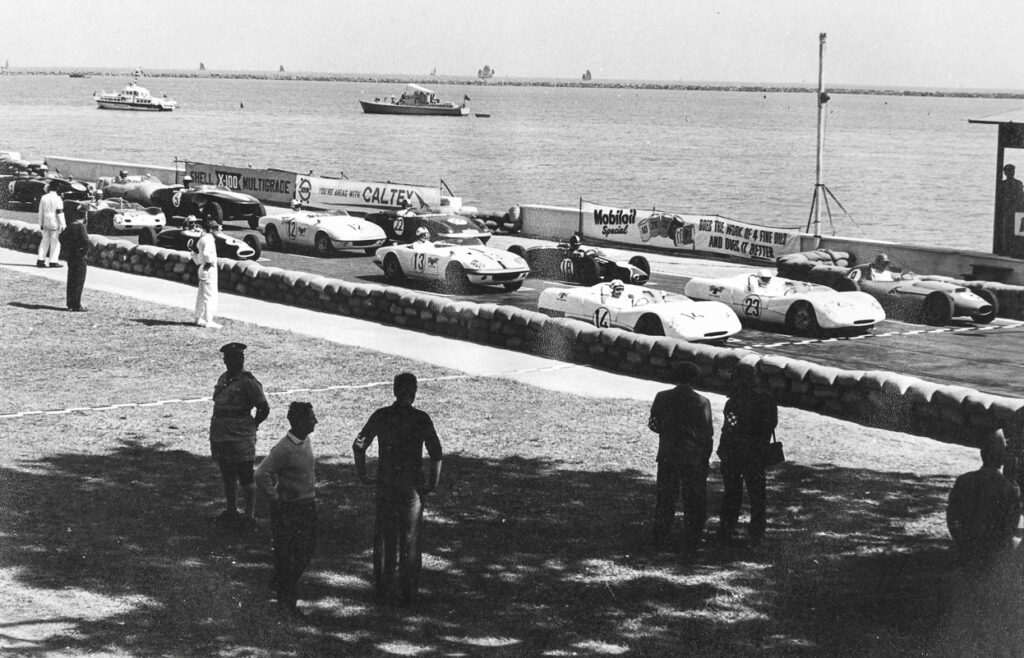
Dr Tony Goodwin started third in his Lola Mk2 (extreme right) in the 1964 Macau Grand Prix. Source: Dr Tony Goodwin
LOST LOLA
One such early model, a Formula Junior Mk3, was imported by Mike Evans in March 1964. Originally delivered with a Holbay Ford 1,500cc motor, Evans replaced it with a Cosworth 1,100cc motor for the 1964 Japanese Grand Prix6 to comply with Formula Junior regulations. The car went to Victor Indran for the 11-12 April 1965 Grand Prix in Singapore (Disqualified for receiving outside assistance at the start). It was raced by Liew Kwong Fai (entered by Indran) with a 1,650cc motor at the TAR races 3-4 July 1965.
Major John Harwood then acquired it, sending the car to Macau for the 28 November Grand Prix. It was the only Lola in an ocean of Lotus entries7. Harwood raced it in Singapore in 1966, at the Fifth TAR races 3-4 September 1966 and again in Singapore in 1967. At the 12 February 1967 Singapore Motor Club Rothmans Old Upper Thomson Road Sprint, Harwood took a class win in the Combined Sports, GT and Racing Cars over 1,500cc class. The car was also raced that weekend by Arthur Whitlock. The car raced in the 25-27 March 1967 Singapore Grand Prix under his Mercury Stable banner, Harwood finishing fourth in the Grand Prix.
Arthur Whitlock, a 23-year-old instruments service engineer with George Kent, then appeared in the car – at the Old Upper Thomson Road Sprint on 6 August 1967, then at the first Batu Tiga Circuit races 2-3 September 1967 and at the Johore Grand Prix 9-10 September 1967. He raced it at Batu Tiga at the First Selangor Grand Prix 6-7 April 1968.
It all went pear shaped for him in Singapore in April 1968 in the Lotus 17. The crash in the Lotus put him in hospital in London for two years! The Lola went to Raymond Tan, reparations for destroying the Lotus 17. Last this writer saw a reference to the Lola Mk3 was in a series of adverts by Raymond Tan Kheng Hiang in 1970 and 1972 – asking SGD$3,200 for the rolling chassis with five speed transmission and magnesium wheels.
It is interesting to note that in 1965, all four Lolas were vying for honours in the Selangor and Singapore races. Tony Goodwin has his Lola Mk2, Victor Indran had the ex-Mike Evans Lola Mk3 Holbay 1,097cc, Brian Stock had the ex-Chan Lola Mk1 Climax and Angus Clydesdale had his Mk1 Special. Clydesdale won his class in the Sports & GT support race to the Grand Prix in Singapore and finished overall (to Philip Seow and a Volvo B18!) but set FTD at 2:55.5. Brian Stock was second in class (to Clydesdale) in the ex-Chan Mk1. In the Grand Prix proper, Indran was disqualified, Goodwin finished third overall, Clydesdale finished fourth and Stock finished seventh.
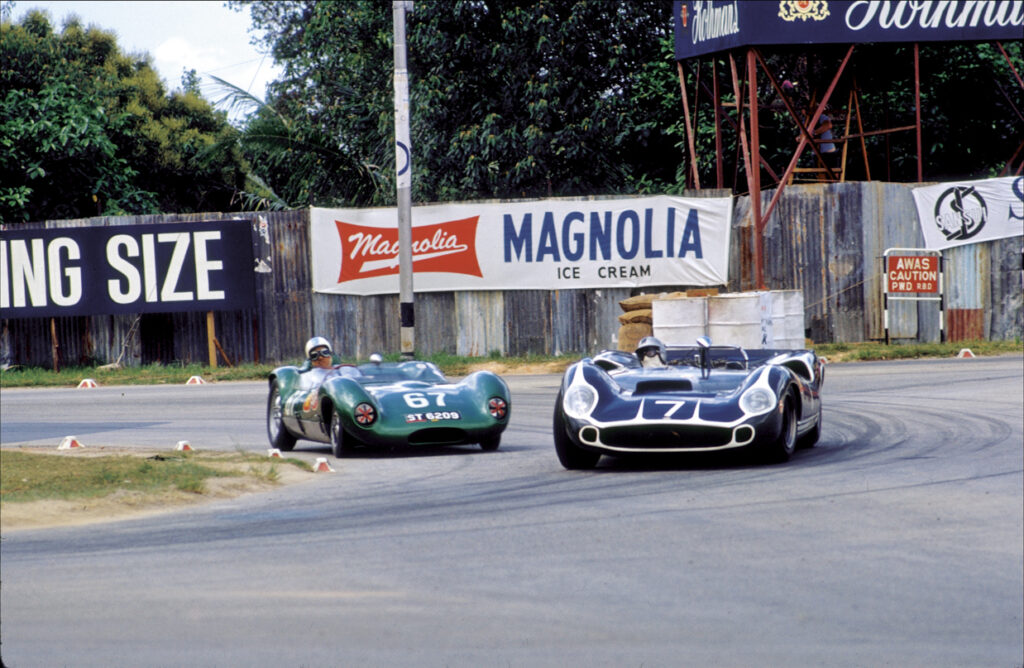
Two generations of Lolas battle it out at the Singapore Grand Prix of 1968. Harry Tan, better known for his association with Kawasaki motorcycles, is swallowed by Denis Geary in the Lola T70 Spyder. The T70 finished second overall (the race was won by Rodney Seow in his Elva Mk7S) and first in the 3,000cc and over class of the Sports and GT support race. Source: Snakes & Devils – A History of the Singapore Grand Prix.

Long in the tooth but still competing in 1968 was Chan Lye Choon’s Mk1 Climax, now racing #67 and in the hands of motorcycle man Harry Tan. Source: Snakes & Devils – A History of the Singapore Grand Prix.
BIG LOLA
The mother of all Lolas, the ground-pounding big-banger T70, belonged on another planet for Can-Am racing. Brought in by Australian Denis Geary just for the 1968 Singapore Grand Prix, it must have made an impression with its sheer speed and sound, but it too was not successful.
Perhaps the diesel laced street circuits of Singapore and Malaysia were simply not equipped to handle Detroit’s the almighty power.
The sports car movement, popular in the region in the 1960s, soon gave way to the purpose-built single-seater racing cars that were brought in with the singular objective of winning the Malaysia, Selangor, Peanng and Macau Grand Prix. Eric Broadley made these as well.
ATLANTIC LOLAS
All went quiet for Lola in Asia from the mid-1960s. A resurgence of interest in Broadley’s offerings came in the early 1970s when the UK manufacturer started producing Formula Atlantic-spec single-seaters. With Malaysia as the de facto stage for racing in Southeast Asia, a trio of T460 Formula Atlantics arrived, entered for the Rothmans Championship series that covered Macau, Penang and Shah Alam.
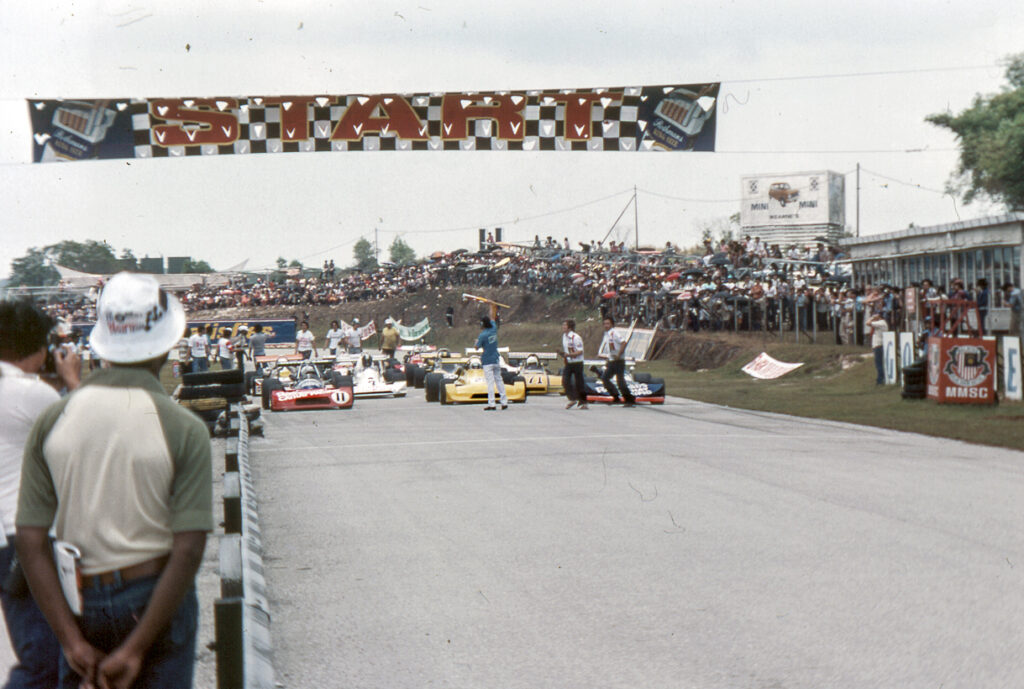
A rare shot of the starting grid for the 50-lap Selangor Grand Prix on 15 August 1976, effectively the first Rothmans Trophy race for the year at Shah Alam. Grant Swartz’s silver Lola T460 is the second car from the left.
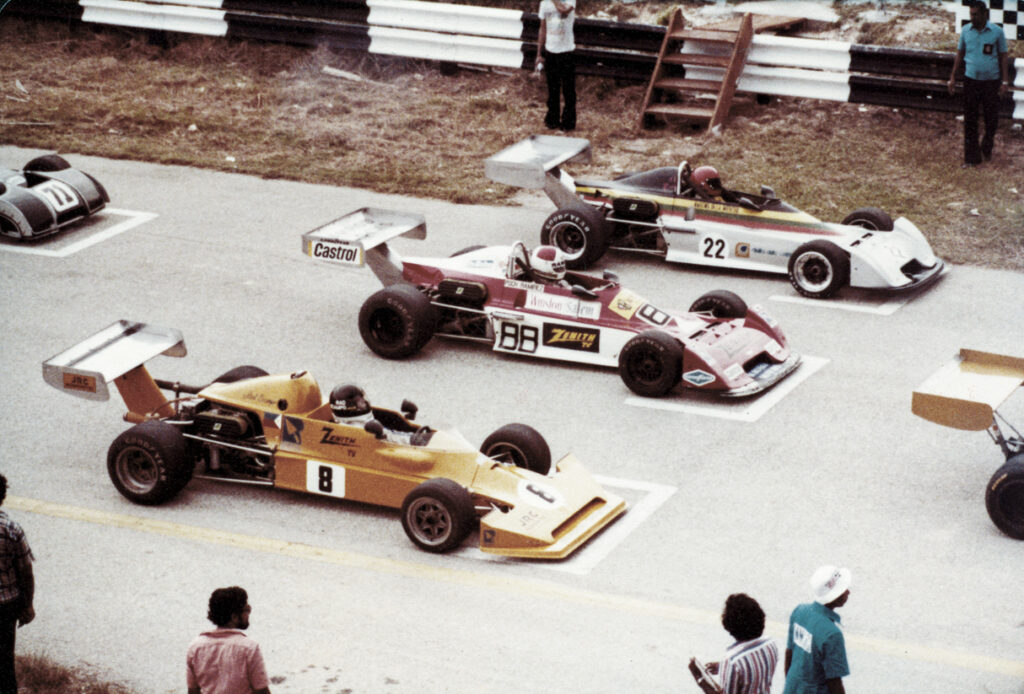
Rad Ocampo’s #8 Lola T460 at the starting grid for the 1978 Malaysia Grand Prix at Shah Alam. Alongside the Lola is Jose “Pocholo” Ramirez’s Chevron B34 and Narcing De La Merced’s similar Chevron. Behind the trio of Filipinos is Ian Grey in an aged Chevron B20. Ocampo’s Lola was the only competing Lola that weekend.
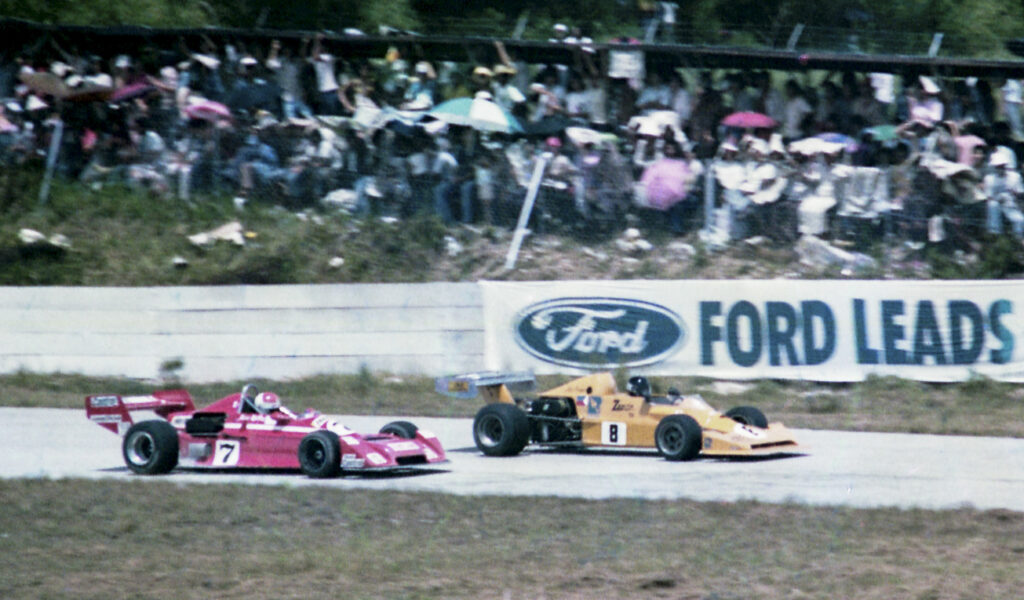
Rad Ocampo’s Lola T460 first raced in Asia in the Malaysian Grand Prix 23-24 April 1977. The photo shows the JCR-sponsored [JCR RamRod Kartway] Ramon Rodriguez-owned car at the 1978 Malaysian Grand Prix. The #7 car is Steve Millen in the Schollum Racing Chevron B42.
They were attractive cars but not successful against the Chevrons, Ralts or the March Atlantics. Chassis rigidity was cited as the cause. A former works development T460 [HU15] 8, run by Indonesian Beng Soeswanto, made a fleeting appearance in 19779, as did Rad Ocambo in a T460 BDA. Tokyo-based American Grant Swartz too had replaced his March 73B [See RIDES OF MARCH – Part 2] with a T460 [HU8][end_note] The Swartz Lola T460 made its Malaysian debut at Shah Alam at the 24-25 April 1976 Malaysian Grand Prix – which was cancelled due to calamitous weather. The car was over in Penang for the 1-2 May Grand Prix, where the car finished fourth, following a broken lower left suspension during Saturday practice. At the 15 August 1976 Selangor Grand Prix, the car finished seventh overall. Swartz entered the car for the XV Indonesian Grand Prix 24 October 1976 and finished third. It was entered for the 14 November 1976 Macau Grand Prix where the cars started in 13th and finished sixth. Swartz was back at Shah Alam for the 23-24 April 1977 Malaysia Grand Prix – though it appears the car DNS-ed. Macau 20 November 1977 appears to be the last time the car appeared in Asia. [/efn_note], sending the car down to Shah Alam for Round 1 of the Rothmans Championship.
After the 1978 racing season, Beng Soeswanto’s car was transformed and bits of it went into the Philippine-made Marlo 01, a combination of bits from the Lola and the ex-Percy Chan March 722 [see RIDES OF MARCH – Part 2]. If this is true then the Rad Ocampo car could still be around – somewhere.
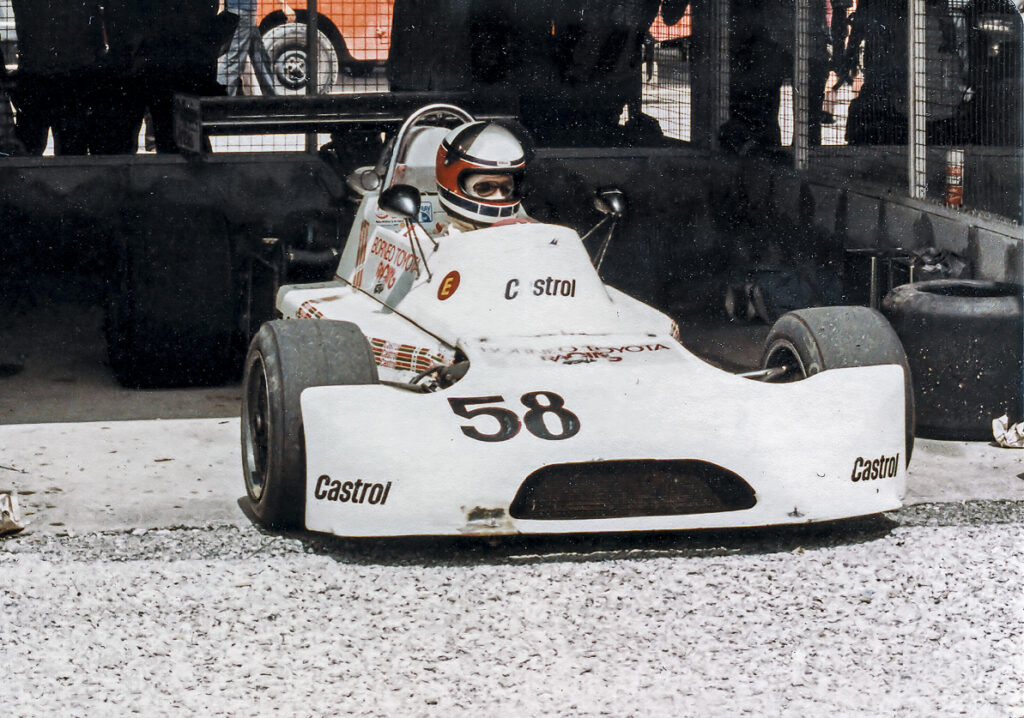
Kookie Ramirez in the Marlo 01 in Shah Alam in the early 1980s. The car was an amalgamation of March 722 tub and 732 front and Lola T460 bits.
Lola’s credentials in the Southeast Asian racing sphere may best be summarized by the type of events held in the 1960s and 1970s. With the Formula Libre series of the 1960s, most of the enthusiasts felt that a sports car better-suited their interests, allowing for entry in Sprints, Hill Climbs and the various circuit races throughout the Peninsula. The Lola Mk1, Lotus 23B and Elva Mk7 offered owners these options.
Into the early 1970s, safety issues, pressure from manufacturers, stricter rules and a far larger variance of speeds segregated the sports and touring cars from the single-seater events, marginalizing the gentleman racer from the professional. Lola’s representation in the international arena was mainly in Sports Racing Cars, Formula Vee and Formula 5000 single-seaters for which they were very successful. But the company did not have a strong Atlantic single-seater to offer that could compete against the likes of Chevron, March and Ralt in the Asian Formula Atlantic series in the late 1970s and early 1980s, and it did not make sense for Lola to deviate from its core strengths.
Bibliography
Pratley, David. Lola’s First: Definitive History of the Mark 1. Bookmarque, 1998
Solomon, Eli. Snakes & Devils – A History of the Singapore Grand Prix. Marchall Cavendisn, Spring 2008
Goodwin, Dr. Tony. Doctor On The Grid. Motor Racing Publications, 2012
Blanden, John B. Historic Racing Cars in Australia. John B. Blanden, 1979
Blanden, John B. Historic Racing Cars in Australia. Turton & Armstrong, 2004
Vercoe, Graham. Historic Racing Cars of New Zealand. Reed Books, 2001
Footnotes
- The Diplomatic Enclave Grands Prix only ran between 1961 and 1963, the latter two years as a mass-start circuit race. In 1964, the Federation International Automobile (FIA) sanctioned motorcycle racing for the MMSC’s third TAR Circuit Race which was set for 4-5 July 1964, but at new 2.7-mile venue in Petaling Jaya which had celebrated its tenth birthday in Feb 1963 as Malaysia’s first ‘new town’. For more on the history of racing in the Federal Capital, see RACING IN THE FEDERAL CAPITAL.
- Leonard Eric Jansz (b. 1923) was Headmaster of the National-Type School at Lenggeng in Seremban. He had previously been a teacher of the King George V School.
- The car was loaded on an RAF Hastings for a “Training” flight from RAF Changi to Kai Tak Airport in Hong Kong, then onto a lighter for the boat ride to Macau.
- Dr Tony Goodwin recalled: “Finally, I had to admit that the old Lola had had its day and arranged for a divorce, having been tempted by a younger Lotus 20B [the ex-Chan Lye Choon car] with Ford 1475cc engine, a wild reputation and an affinity to engage with the local drains. Lola, knowing her days were numbered, bravely scampered to the top of the notorious Dunlop Gap Hill Climb, not far from the Tiger Balm Gardens in Singapore, to take Fastest Time of Day [possibly at the 30 May 1965 Gap]; but the divorce became absolute on the eve of the next race in KL at the beginning of July [1965]. She continued to appear in Far Eastern events for a year or two before getting lost in the Jungle.”
- Singapore Motor Sports Club Gazette, July 1974.
- Mike Evans entered the Lola Mk3 with race number 21. The car completed 6 of 15 laps and was classified 11th.
- Harwood’s friend Dr Tony Goodwin joined him in Macau, entered in the ex-Chan Lye Choon Lotus 20B.
- https://www.oldracingcars.com/atlantic/results/seasia/1977/malaysia/#note10
- Beng Soeswanto appeared in the T460 on 3 January 1977 at Baypark for the Peter Stuyvesant NZ Formula Pacific series. He missed the 9 January 1977 Pukekohe race but attended the 16 January Manfeild race where he DNF-ed (clutch). On 23 January he was classified 12th at Teretonga Park but DNF-ed at the 30 January Wigram race. The car was shipped up to Shah Alam for the 23-24 April 1977 Malaysia Grand Prix (which was cancelled).

